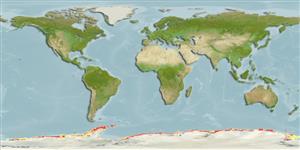Teleostei (teleosts) >
Perciformes/Notothenioidei (Icefishes) >
Nototheniidae (Cod icefishes) > Trematominae
Etymology: Trematomus: Greek, trematos = hole + Greek, tomo = section, cut (Ref. 45335); newnesi: newnesi named after Sir George Newnes, British newspaper publisher who sponsored Borchgrevinck's Expedition of 1899 (Ref. 11892).
Eponymy: Sir George Newnes (1851–1910) was a British newspaper publisher and Liberal politician. He sponsored the Southern Cross Expedition (1898–1900) to Antarctica. (Ref. 128868), visit book page.
More on author: Boulenger.
Environment: milieu / climate zone / depth range / distribution range
Ecology
Marine; demersal; depth range 0 - 400 m (Ref. 11892). Polar; 60°S - 78°S
Southern Ocean: East Antarctic, Weddell Sea, West coast of Antarctic Peninsula, South Shetland Islands, Elephant Island, South Orkney Islands, Mac Robertson, George V, Queen Mary, Adelie Coasts, Davis Sea and Ross Sea.
Size / Weight / Age
Maturity: Lm ? range ? - ? cm
Max length : 24.5 cm TL male/unsexed; (Ref. 58849)
Found in shallow near shore areas and more commonly in the intertidal zone. Adults feed mainly on amphipods, polychaetes, gastropods, isopods, copepods, and euphausiids (E. superba). Often seen feeding in the water column or at the undersurface of ice.
Life cycle and mating behavior
Maturity | Reproduction | Spawning | Eggs | Fecundity | Larvae
Dewitt, H.H., P.C. Heemstra and O. Gon, 1990. Nototheniidae. p. 279-331. In O. Gon and P.C. Heemstra (eds.) Fishes of the Southern Ocean. J.L.B. Smith Institute of Ichthyology, Grahamstown, South Africa. (Ref. 5179)
IUCN Red List Status (Ref. 130435: Version 2024-1)
Threat to humans
Harmless
Human uses
Fisheries: of no interest
Tools
Can't connect to MySQL database fbquizv2. Errorcode: Too many connections
